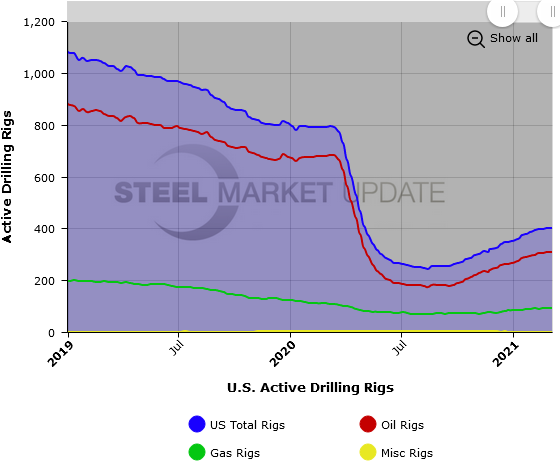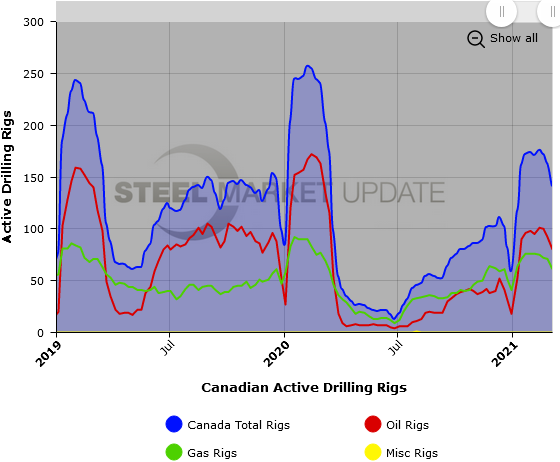Canada

March 5, 2021
Active Gas & Oil Rig Counts in U.S. and Canada
Written by Brett Linton
The number of active U.S. rotary drill rigs was relatively unchanged this past week, while the Canadian rig count declined, according to data released by oilfield services company Baker Hughes. The rig count is important to the steel industry because it is a leading indicator of oil country tubular goods demand.
SMU Note: Our last Community Chat Webinar featured energy expert Rick Preckel, partner at Preston Pipe, who discussed the improvement of the oil and gas sector and more. Click here to view the article covering his comments.
The number of active U.S. rigs rose by 1 to 403 rigs, with oil rigs up 1, gas rigs unchanged, and miscellaneous rigs unchanged. Compared to this time last year, this week’s count is down 390 rigs, with oil rigs down 372, gas rigs down 17, and miscellaneous rigs down 1. See the first graph below for a history of active U.S. rig counts.
The Canadian rig count fell by 22 to 141 rigs, with oil rigs down 12, gas rigs down 10, and miscellaneous rigs unchanged. Compared to last year, this week’s count is down 62 rigs, with oil rigs down 54, gas rigs down 8, and miscellaneous rigs unchanged. See the second graph below for a history of active Canadian rig counts.
International rigs increased by 24 to 701 rigs for the month of February, a decrease of 384 rigs from the same month one year ago. For a history of both the U.S. and Canadian rig count, visit the Rig Count page on the Steel Market Update website here.
For more in-depth information on the energy market, Steel Market Update publishes a report each month covering oil and natural gas prices, detailed rig count data, and oil stock levels for our Premium members. The most recent report is available to Premium members here.
About the Rotary Rig Count
A rotary rig is one that rotates the drill pipe from the surface to either drill a new well or sidetrack an existing one. They are drilled to explore for, develop and produce oil or natural gas. The Baker Hughes Rotary Rig count includes only those rigs that are significant consumers of oilfield services and supplies.
The Baker Hughes North American Rotary Rig Count is a weekly census of the number of drilling rigs actively exploring for or developing oil or natural gas in the United States and Canada. Rigs considered active must be on location and drilling. They are considered active from the time they break ground until the time they reach their target depth.
The Baker Hughes International Rotary Rig Count is a monthly census of active drilling rigs exploring for or developing oil or natural gas outside of the United States and Canada. International rigs considered active must be drilling at least 15 days during the month. The Baker Hughes International Rotary Rig Count does not include rigs drilling in Russia or onshore China.
By Brett Linton, Brett@SteelMarketUpdate.com










